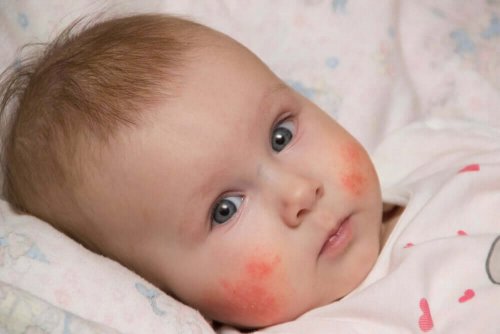The Differences between Atopic and Seborrheic Dermatitis


Written and verified by the doctor Leonardo Biolatto
Atopic and seborrheic dermatitis are two are very common skin conditions. Although many people tend to confuse the two, in reality, they’re completely different.
Atopic dermatitis is a skin condition that usually causes redness, itching, and dryness. It’s believed that genetics is one of the most important risk factors. However, experts also believe that environmental factors and food are influencing factors. On the other hand, seborrheic dermatitis causes scaly patches and skin redness. It’s like having persistent dandruff. However, it’s a condition that can affect all the bodily areas where more sebum is produced, including the eyebrows, face, or ears.
Both atopic and seborrheic dermatitis cause skin irritation and bothersome related symptoms. However, there are many differences between the two conditions. We’ll explain them to you below.
Who’s affected by atopic and seborrheic dermatitis?
Interestingly, this is one of the main keys to the diagnosis of both conditions. Atopic and seborrheic dermatitis tend to affect different groups of people.
First of all, atopic dermatitis mostly affects children and adolescents. In fact, it’s estimated that it affects 20% of the general population. Interestingly, to diagnose this condition, doctors focus on the person’s personality. This is because atopic skin is very itchy and burns. When it affects babies who can’t express themselves, they often have a very characteristic personality, as they’re irritable and nervous.
However, seborrheic dermatitis has two peaks of incidence. It usually manifests during the first months of life or after puberty. It also tends to affect more men than women. Fortunately, it affects only about 5% of the population.

What are the symptoms of atopic and seborrheic dermatitis?
Atopic and seborrheic dermatitis cause itchy and red skin. However, each condition causes its own symptoms.
For example, in the case of atopic dermatitis, this itch usually worsens at night. Furthermore, atopic dermatitis causes skin dryness. Consequently, the itching causes the affected person to scratch, which ends up causing skin peeling and swelling. Red spots also appear on many parts of the body, such as the hands, feet, or neck. Plus, the skin thickens and cracks due to the dryness. It’s common for whitish and scaly patches to appear on the elbow creases, for example. They’re similar to those that occur in pityriasis alba and also cause itching.
On the other hand, seborrheic dermatitis results in a kind of dandruff in the hair, eyebrows, or even beard. Also, this condition causes greasy spots of skin that are usually covered with white or yellow scales to appear. This is called “cradle cap”. These “scales” usually occur on both sides of the nose, eyebrows, and eyelids, among other places. This means that they appear in all the areas where the body produces more sebum. It’s also common to find areas with scaly, reddened skin.
Finally, it’s important to know that another difference between atopic and seborrheic dermatitis is the way they manifest. Atopic dermatitis commonly manifests with periodic exacerbations and temporary disappearances that can last years. Seborrheic dermatitis worsens with stress or cold and dry seasons.
You may also like this article: Effective Natural Remedies for Seborrheic Dermatitis
Other major differences
Atopic and seborrheic dermatitis also differ regarding how they affect infants, as seborrheic dermatitis doesn’t cause any discomfort in babies. However, as we mentioned above, atopic dermatitis may cause the child to suffer, which is why they’re almost always irritated.
Another difference is skin hydration. While seborrheic dermatitis makes the skin look greasy, atopic dermatitis causes skin dryness. However, to treat both conditions, it’s essential to keep the skin moisturized.

Read on to learn more: Learn How to Help Relieve Atopic Dermatitis Symptoms
Conclusion
Although both pathologies can affect newborns, it’s important to know the characteristics of each to indicate an appropriate treatment. This way, you’ll also avoid the factors that worsen them.
When in doubt, don’t hesitate to consult a specialist.
All cited sources were thoroughly reviewed by our team to ensure their quality, reliability, currency, and validity. The bibliography of this article was considered reliable and of academic or scientific accuracy.
- Eucerin: Acerca de la piel | Dermatitis seborreica. (n.d.). Retrieved September 29, 2019, from https://www.eucerin.es/acerca-de-la-piel/indicaciones/dermatitis-seborreica
- Dermatitis atópica (eczema atópico) Eczema Symptoms & Treatment. (n.d.). Retrieved September 29, 2019, from https://www.aaaai.org/conditions-and-treatments/library/allergy-library/sp-eczema-atopic-dermatitis
- Diferencia entre dermatitis atópica y seborreica – FarmaTopVentas. (n.d.). Retrieved September 29, 2019, from https://www.farmatopventas.es/blog/dermatitis-atopica-y-dermatitis-seborreica.html
This text is provided for informational purposes only and does not replace consultation with a professional. If in doubt, consult your specialist.








